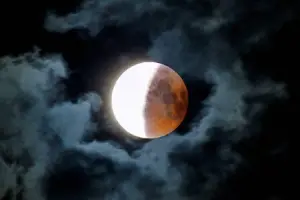Moon eclipse 2024

Lunar eclipses are observable from the entire Earth-facing hemisphere, offering a universally similar view of the dimmed Moon, unlike solar eclipses’ limited visibility.
Duration and Types of Lunar Eclipses 2024
The longest total lunar eclipses can reach 108 minutes, with central eclipses marking the peak duration and intensity. These central eclipses traverse Earth’s shadow center, contrasting with shorter, less vivid non-central eclipses.
The Phenomenon of the Blood Moon
Even during total eclipses, the Moon remains visible but adopts a reddish hue, known as the Blood Moon. This effect is due to Earth’s atmosphere filtering sunlight, letting through more red-orange rays that illuminate the Moon.
View from the Moon
Observers on the Moon’s shadowed side during an eclipse would witness a total solar eclipse caused by the Earth.
Partial and Penumbral Eclipses
Partial eclipses occur when the Moon only partly enters Earth’s shadow, leading to a mix of darkened and lit sections. Penumbral eclipses, involving the Moon’s passage through Earth’s penumbral shadow, result in only slight dimming, often hard to discern without instruments.
Periodicity
The occurrence of lunar eclipses isn’t guaranteed with every full moon due to the misalignment of the Moon’s orbit with Earth’s orbital plane. Annually, the number of lunar eclipses can vary from a minimum of two to a maximum of four, as seen in years like 2020 and 2038. The repetition of eclipses in an 18-year, 11-day cycle known as a saros allows for precise prediction and historical dating of these celestial events. This cyclical nature is a valuable tool for understanding past and future lunar eclipses in specific locations.
Easter Weather Across Australia
Warm Temperatures in Key Cities: Melbourne and Darwin are expected to experience highs of 32 degrees during the Easter weekend, making for a warm holiday period in these major cities.
Northern and Interior Heat: A significant portion of Australia’s north and interior regions will face hot conditions, with temperatures set to rise notably during the long weekend.
Celestial Alignment and Its Effects 2024
During certain periods, the moon aligns closely with the sun and Earth, casting Earth’s penumbral shadow onto the moon. Dr. Shannon Schmoll from Abrams Planetarium explains that this alignment results in a subtle darkening gradient across the moon’s surface, rather than a dramatic change in appearance.
For optimal viewing times in your area, consult the Time And Date website. Unlike a total lunar eclipse, where the moon turns red, a penumbral eclipse is subtler and doesn’t require special equipment for observation. According to Dr. Shannon Schmoll, you only need a clear view of the moon. Such celestial events encourage us to appreciate the universe from our vantage point on Earth. This will be Australia’s only visible eclipse until next March.
Frequency and Rarity of Eclipses
Total penumbral eclipses, where the Moon is fully within the penumbra but avoids the umbra, are rare, with significant gaps between occurrences.
Tonight, Australians are in for a treat as they can experience a penumbral lunar eclipse, a subtle yet captivating celestial phenomenon. This occurs when the moon, Earth, and sun align, causing Earth’s outer shadow, the penumbra, to cast a slight shadow on the moon’s surface. Observers might notice a gradual dimming effect across the moon, with one side appearing fainter than the other. The eclipse will be visible in various global regions, including Australia, where it’s set to peak in Sydney at 7.03pm and in Melbourne at 7.29pm tonight. This event promises a unique viewing experience for those under the night sky during the eclipse.






























Leave your commentary